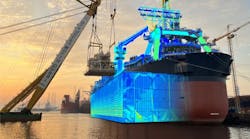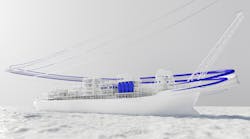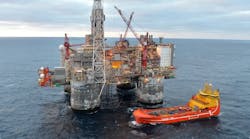Editor's note: This Beyond the Horizon first appeared in the September-October 2023 issue of Offshore magazine. Click here to view the full issue.
By Matt Mohajer, SLB; and Greg Trostel, Rockwell Automation
Traditionally, the offshore industry has been highly compartmentalized and competitive. But these old ways of working are no longer serving us well when it comes to the design, build, and operation of our complex facilities, particularly FPSOs. Currently, stakeholders tend to work in closed ecosystems, using manual workflows, and implementing single-point solutions to which digital enablement and automation are back-applied, not designed in. It’s going to take greater openness and collaboration starting from early engagement to digitally accelerate the technology development and operational changes necessary for evolving FPSO performance to a level not previously possible.
With nearly 60 FPSOs expected to begin operations over the next five years and increased capex planned for refurbishing existing vessels, obviously the demand for deepwater production is a significant driver for the offshore industry. This is not just a call to increase the number of FPSOs. There is a concurrent focus on optimizing production throughput, ensuring equipment uptime, and reducing carbon footprint. However, the old ways of working are not serving the offshore industry well for increasing the efficiency, safety, and sustainability of FPSO operations. Stakeholders tend to design, build, and operate FPSOs in what are essentially closed ecosystems, rife with manual workflows, lack of scalability, and sequentially incorporated single-point solutions. Digital solutions are typically implemented as isolated applications, which limits their effectiveness.
The offshore industry’s need for speed in meeting market demands can be accomplished only through greater transparency and collaboration. Open collaboration is the driver and digitalization is the necessary change agent, but it cannot exist in a vacuum. Digital must be integrated with automation and contextual data and analytics in an open digital infrastructure that connects and integrates disparate systems. This in turn will enable collaboration with experts and partners that can help improve a particular FPSO’s performance. We must do away with the industry’s current knowledge and technology silos. Baked into the open collaboration model is the principle that the performance of any single component of an FPSO cannot be addressed without considering the whole; therefore, the collaborating entities must have experience and expertise across the subsurface, subsea, and topside domains.
A second call to change in concert with open collaboration is early engagement. Operators cannot continue to treat digitalization and automation as late-cycle add-ons. The earliest possible introduction of open collaboration, whether in the design and build phases of a new FPSO or in the operations phase for existing FPSOs, provides the greatest number of opportunities for assuring equipment performance and uptime, optimizing production throughput, and reducing the carbon footprint at scale. Value continues to accrue as collaboration continues across the life cycle of the asset.
Open collaboration is the ideal approach to addressing an ongoing challenge for offshore operators: producing more with fewer resources. Succeeding at this requires the availability of critical equipment. By collaborating to implement data-contextualized asset performance management (APM) across numerous systems and providers, FPSO operators have full visibility, accountability, and control across the vessel. Within its secure open data platform, APM brings together data capture, integration, visualization, and analytics across six facets: asset health and reliability, maintenance management, site execution, integrity and process safety, and production integration.
A primary support for a high-functioning APM is remote and autonomous operations that generate the necessary process data feeding digital applications and informing the facility’s digital twin. From this data basis, users and AI routines generate actionable insights within APM through analytics and simulation. It must be emphasized that the implementation of digitalization of an FPSO requires that the architecture and measurement devices are in place and in continuity with robotics and automation aspects, with this foundational requirement best implemented early in the project life cycle.
The challenges faced by FPSO operations will only continue to intensify. Now is the time for our industry to work collaboratively to develop the technology necessary to evolve FPSO performance across all phases of each vessel’s life cycle. And that technology must include digitalization, automation, and data contextualization. Only by working together, rather than in isolation, and as early in a project cycle as possible can we intelligently accelerate the evolution of FPSOs to greater reliability, productivity, and sustainability.









